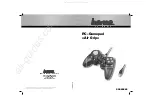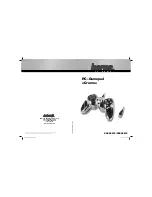
CHAPTER 2: PRODUCT DESCRIPTION
PILOT CHANNEL RELAYING
L30 LINE CURRENT DIFFERENTIAL SYSTEM – INSTRUCTION MANUAL
2-5
2
2.1.1.6 Metering
•
Actual 87L remote phasors, differential current, channel delay, and channel asymmetry at all line terminals of line
current differential protection
•
Line current, voltage, real power, reactive power, apparent power, power factor, and frequency
2.1.1.7 Communications
•
Front panel RS232 port: 19.2 kbps
•
Rear RS485 port: up to 115 kbps
•
Rear 100Base-FX Ethernet port supporting the IEC 61850 protocol
2.2 Pilot channel relaying
2.2.1 Inter-relay communications
Dedicated inter-relay communications can operate over 64 kbps digital channels or dedicated fiber optic channels.
Available interfaces include:
•
RS422 at 64 kbps
•
G.703 at 64 kbps
•
Dedicated fiber optics at 64 kbps, including
–
820 nm multimode fiber with an LED transmitter
–
1300 nm multimode fiber with an LED transmitter
–
1300 nm single-mode fiber with an ELED transmitter
–
1300 nm single-mode fiber with a laser transmitter
–
1550 nm single-mode fiber with a laser transmitter
–
IEEE C37.94 820 nm multimode fiber with an LED transmitter
All fiber optic options use an ST connector. L30 models are available for use on two or three terminal lines. A two terminal
line application requires one bidirectional channel. However, in two terminal line applications, it is also possible to use an
L30 relay with two bidirectional channels. The second bidirectional channel provides a redundant backup channel with
automatic switchover if the first channel fails.
The L30 current differential relay is designed to function in a peer-to-peer or master-to-master architecture. In the peer-to-
peer architecture, all relays in the system are identical and perform identical functions in the current differential scheme. In
order for every relay on the line to be a peer, each relay must be able to communicate with all of the other relays. If there is
a failure in communications among the relays, the relays revert to a master-to-peer architecture on a three-terminal
system, with the master as the relay that has current phasors from all terminals. Using two different operational modes
increases the dependability of the current differential scheme on a three-terminal system by reducing reliance on
communications.
The main difference between a master and a slave L30 is that only a master relay performs the actual current differential
calculation, and only a master relay communicates with the relays at all other terminals of the protected line.
At least one master L30 relay must have live communications to all other terminals in the current differential scheme; the
other L30 relays on that line operate as slave relays. All master relays in the scheme are equal, and each performs all
functions. Each L30 in the scheme determines if it is a master by comparing the number of terminals on the line to the
number of active communication channels.
The slave terminals only communicate with the master; there is no slave-to-slave communications path. As a result, a
slave L30 cannot calculate the differential current. When a master L30 relay issues a local trip signal, it also sends a direct
transfer trip (DTT) signal to all of the other L30 relays on the protected line.
If a slave L30 issues a trip from one of its backup functions, it can send a transfer trip signal to its master and other slave
relays if such option is designated. Because a slave cannot communicate with all the relays in the differential scheme, the
master then “broadcasts” the direct transfer trip (DTT) signal to all other terminals.
Содержание L30
Страница 10: ...x L30 LINE CURRENT DIFFERENTIAL SYSTEM INSTRUCTION MANUAL TABLE OF CONTENTS ...
Страница 14: ...1 4 L30 LINE CURRENT DIFFERENTIAL SYSTEM INSTRUCTION MANUAL FOR FURTHER ASSISTANCE CHAPTER 1 INTRODUCTION 1 ...
Страница 126: ...3 68 L30 LINE CURRENT DIFFERENTIAL SYSTEM INSTRUCTION MANUAL CONNECT TO D400 GATEWAY CHAPTER 3 INSTALLATION 3 ...
Страница 214: ...4 88 L30 LINE CURRENT DIFFERENTIAL SYSTEM INSTRUCTION MANUAL FLEXLOGIC DESIGN USING ENGINEER CHAPTER 4 INTERFACES 4 ...
Страница 582: ...7 16 L30 LINE CURRENT DIFFERENTIAL SYSTEM INSTRUCTION MANUAL TARGETS MENU CHAPTER 7 COMMANDS AND TARGETS 7 ...
Страница 598: ...9 6 L30 LINE CURRENT DIFFERENTIAL SYSTEM INSTRUCTION MANUAL TESTING CHAPTER 9 COMMISSIONING 9 ...
Страница 622: ...10 24 L30 LINE CURRENT DIFFERENTIAL SYSTEM INSTRUCTION MANUAL FAULT LOCATOR CHAPTER 10 THEORY OF OPERATION 10 ...
Страница 670: ...A 18 L30 LINE CURRENT DIFFERENTIAL SYSTEM INSTRUCTION MANUAL FLEXANALOG ITEMS APPENDIX A FLEXANALOG OPERANDS A ...
Страница 678: ...C 6 L30 LINE CURRENT DIFFERENTIAL SYSTEM INSTRUCTION MANUAL COMMAND LINE INTERFACE APPENDIX C COMMAND LINE INTERFACE C ...
Страница 682: ...D 4 L30 LINE CURRENT DIFFERENTIAL SYSTEM INSTRUCTION MANUAL REVISION HISTORY APPENDIX D MISCELLANEOUS D ...
Страница 686: ...iv L30 LINE CURRENT DIFFERENTIAL SYSTEM INSTRUCTION MANUAL ABBREVIATIONS ...
















































